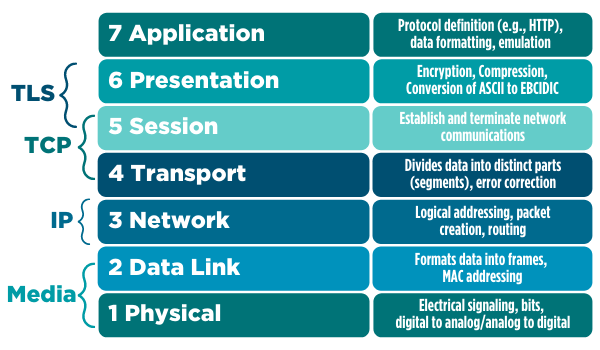The OSI Model: What is it?
The OSI (Open Systems Interconnection) model is a conceptual model that defines the different layers involved in computer networking. Everyone who works in computing should understand this.

The OSI (Open Systems Interconnection) model is a conceptual model that defines the different layers involved in computer networking. It was developed by the International Organization for Standardization (ISO) to provide a standard framework for the design and implementation of computer networks. The OSI model has seven layers, each with its own specific functions and protocols:
- Physical Layer - Defines the electrical, mechanical, and physical characteristics of the network. It defines how data is transmitted over the network medium, such as wires or cables.
- Data Link Layer - Defines the protocols for transferring data between adjacent network nodes. This layer is responsible for error detection and correction, as well as addressing and packet framing.
- Network Layer - Defines how data is transmitted over a network. This layer is responsible for routing, switching, and addressing, and ensures that data is transmitted to the correct destination.
- Transport Layer - Defines the protocols for transferring data between applications on different hosts. This layer is responsible for error recovery, flow control, and congestion control.
- Session Layer - Defines how applications establish, manage, and terminate sessions between them. This layer is responsible for managing the communication session between applications.
- Presentation Layer - Defines how data is presented to applications. This layer is responsible for data encryption, compression, and conversion.
- Application Layer - Defines the protocols and services that applications use to exchange data. This layer includes protocols such as HTTP, FTP, and SMTP.

Understanding the OSI model is important because it provides a standard framework for the design and implementation of computer networks. It helps network engineers and designers to better understand how different network components and protocols work together to create a functioning network. It also helps in troubleshooting and diagnosing network issues, by isolating problems to specific layers of the OSI model.
Additionally, the OSI model serves as a reference point for developing and implementing new network technologies and protocols. By adhering to the OSI model, network engineers can ensure that their implementations are interoperable with other network components and devices.
In summary, the OSI model is important to understand as it provides a standard framework for the design and implementation of computer networks, helps in troubleshooting and diagnosing network issues, and serves as a reference point for developing and implementing new network technologies and protocols.
